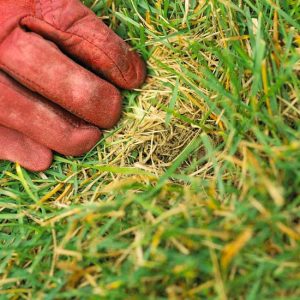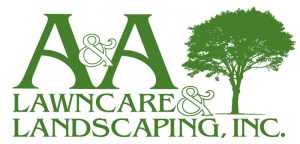
Brown Patch
Large patches of yellowing, brownish grass with dark rings outlining it is called Brown Patch. It is a turfgrass disease that is caused by the Rhizoctonia species fungus. This turfgrass disease is most common. Small patches of dead grass. True to their name Dollar Spot appears as tan or straw-colored spots ranging in size from a quarter to that of a silver dollar sunken in the turf. Occasionally, small cottony strings of the fungus can be seen growing from the diseased leaf blades., these patches are typically round and the approximate diameter of a silver dollar coin.
Anthracnose
Discolored patches in the lawn that range in color from yellow to red is called Anthracnose. It is caused by fungi that are responsible for diseases on many plant species. Infected plants develop dark, water soaked lesions on stems, leaves or fruit. With time, these patches spread and the roots turn black in color.
Fairy Ring
A Fairy Ring, also known as fairy circle, elf circle, elfring or pixie ring, is a naturally occurring ring or arc of mushrooms. The rings may grow to over 10 metres (33 ft) in diameter, and they become stable over time as the fungus grows and seeks food underground.this fungal disease can consist of either mushrooms or dead grass forming circles in the grass.
Lawn Rust
Grass leaf blades, especially in late summer to early fall when the weather is dry. Lawn Rust typically develops on lawns and other turf areas growing very slowly. Overall, the turf may assume a yellow, red, or brown appearance. Close examination will reveal the pustules, which easily rub off on your hand . Lawn rust is a rusty, orange-colored powder that coats grass blades.
Leaf Spot
Brown and black spots with tan centers that form on grass blades, killing the blade is called Leaf Spot. This is usually followed by a melting out phase in which a red mold takes over the affected grass.
Nutsedge
Nutsedge is a bright green, very stubborn weed that is not preventable. It starts to pop up in the summer months due to the heat and humidity in the lawn, and because nutsedge grows about twice as fast as grass, becomes quite noticeable quickly. Around the outside of nutsedge is a waxy coating that is hard to penetrate, making the weed difficult to kill off. A & A combats this by using prosedge with a sticker agent included, multiple times to penetrate that coating and kill off the weed. It is very normal to get nutsedge during summer months, even if you are using regular lawn service. We recommend to always keep an eye on the weed and let us know if further applications are needed.
Pink Snow Mold
Matted circles of grass covered in pinkish-colored mold is called Pink Snow Mold. It is found anywhere on a grass blade, from the root to the crown.
Slime Mold
Irregularly shaped patches of gray-yellow dust coating the grass blades is called Slime Mold. It is not a plant or animal. It’s not a fungus, though it sometimes resembles one. Slime mold, in fact, is a soil-dwelling amoeba, a brainless, single-celled organism.
Rythium Blight
Dark green to purple water-soaked leaves that aggregate into circular or irregularly shaped patches in turfgrass is called Pythium Blight. No distinct lesions are formed on infected leaves, which often feel slimy or greasy when rubbed between two fingers. Patches of infected grass can enlarge and coalesce, causing severe damage to lawns, golf courses and athletic field turf
Red Thread
A a fungal structure resembling a thread that grows on the grass blades is called Red Thread.
Dead Spot
Dead, matted, flattened grass forming circles and semi-circles on a lawn is called Spring Dead Spot
Summer Patches
Patches of dead grass that form rings or semi-circles with a bronze-colored outline is called Summer Patches. These rings usually suffer and eventually die.
If you believe that your lawn is suffering from one of these conditions,and you are confused about the condition, contact a professional like A&A right away. We have years of experience in diagnosing and treating lawn diseases of all kinds.
Contact Us (859-384-0266) for a Free Consultation!
—
 About A & A Lawn Care & Landscaping
About A & A Lawn Care & Landscaping
A & A Lawn Care & Landscaping can beautify your lawn and landscaping using our vast experience in turf grass management. Our complete lawn service is designed for both residential and commercial lawns and we keep your lawn healthy without harming your family, staff, or pets.

 About A & A Lawn Care & Landscaping
About A & A Lawn Care & Landscaping